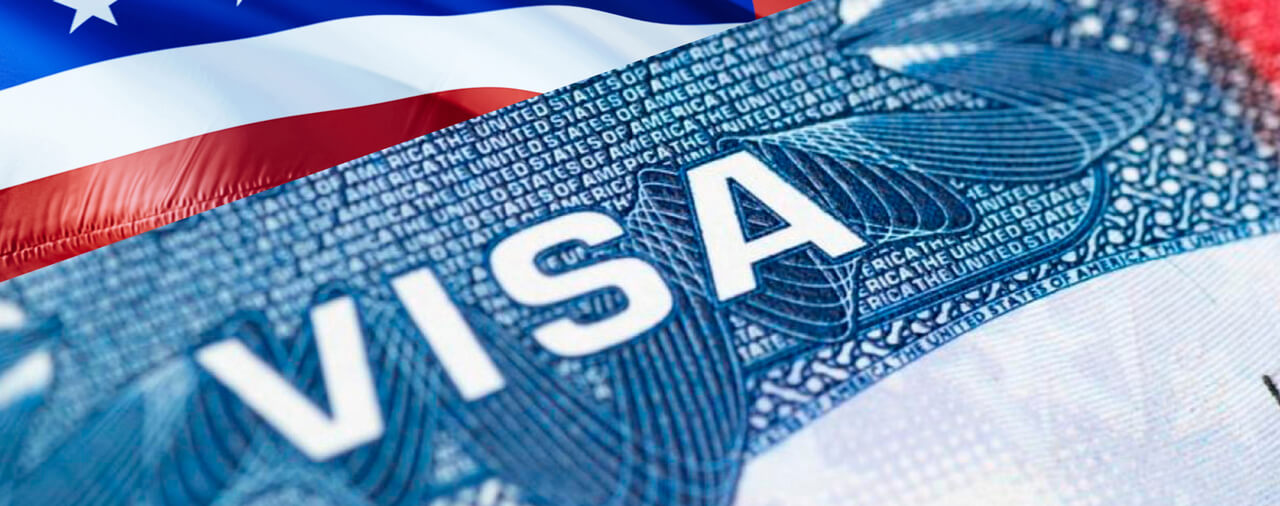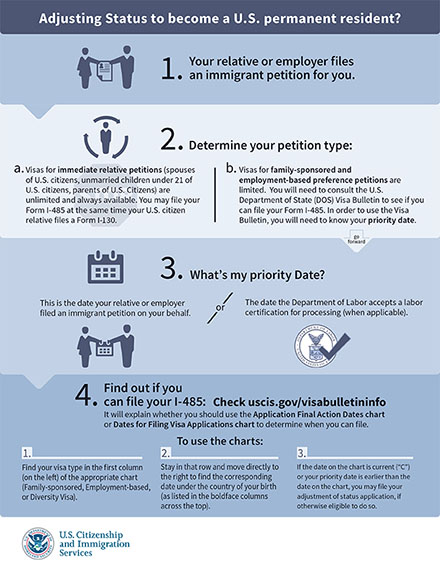- Introduction: Using the DOS Immigrant Visa Bulletin for AOS Filings
- Difference Between Final Action Dates and Filing Dates
- How to Use the Charts for Adjustment of Status
- Consular Processing
- Conclusion
Introduction: Using the DOS Immigrant Visa Bulletin for AOS Filings
Each month, the Department of State (DOS) releases an Immigrant Visa Bulletin. The Bulletin includes two charts for both family-sponsored and employment-based cases showing when people can file for immigrant visas. These charts contain the “application final action dates” and the “dates for filing” respectively.” The United States Citizenship and Immigration Services (USCIS) determines each month whether adjustment of status applicants in the family-sponsored and employment-based preference categories must use the final action dates or the dates for filing. In this article, we will explain how to use the charts, the differences between the charts, and where you can find more information on our website.
To read more about the differences between the charts, please see our blog post from when the dates for filing charts were introduced [see article].
Difference Between Final Action Dates and Filing Dates
Starting in fiscal year 2016, the DOS began publishing two charts for both family-sponsored and employment-based preference cases. These charts contain what are called the “final action dates” and the “filing dates” respectively. Both sets of dates are based on the number of available immigrant visa numbers and the number of documentarily qualified applicants. Each month, the USCIS will assess the number of available immigrant visas and the number of documentarily qualified aliens seeking immigrant visas to determine which chart those seeking adjustment of status must use.
In general, the cutoff dates on the filing date chart are later than the cutoff dates on the final action date chart. This means that in months when the USCIS allows applicants to use the filing date charts, more people will be eligible to apply for adjustment of status. For fiscal year 2016, the USCIS allowed family-sponsored adjustment of status applicants to use the filing date charts for seven months (October 2015-April 2016). However, employment-sponsored applicants were only allowed to use the filing dates for the first two months of fiscal year 2016 (October 2015-November 2015).
How to Use the Charts for Adjustment of Status
The DOS is required to issue a monthly Visa Bulletin designed to manage the annual allocation of immigrant visas in the preference categories. This is because, under statute, there are only a limited number of immigrant visas available annually in each of the preference categories. The limits are calculated for each fiscal year. The fiscal year begins on October 1 and concludes on September 30.
Using the Visa Bulletin is quite simple for adjustment of status applicants. First, the applicant must have an approved immigrant visa petition in one of the preference categories. If the applicant’s petition is still pending, he or she is not yet eligible to apply for an adjustment of status. If the applicant does have an approved immigrant visa petition in one of the preference categories, he or she may then consult the Visa Bulletin. The applicant must first ensure that he or she is using the correct chart. As we will discuss in the next section, the USCIS determines each month whether an adjustment of status applicant must use the final action dates chart or the dates for filing chart in determining when he or she may file for an immigrant visa.
After identifying the correct chart, the applicant must find his or her preference category on the family-sponsored or employment-based chart. Next, the applicant must find the right section based on his or her country of nationality. As of the October 2016 Visa Bulletin, China, India, Mexico, and the Philippines have distinct final action dates and dates for filing in the family-sponsored categories. For employment-based categories, these countries plus El Salvador, Guatemala, and Honduras have distinct dates.
After finding the correct date, the applicant must determine whether his or her priority filing date is before the application final action date or the filing date, whichever is in use that month. If the priority date is before the final action or filing cutoff date (whichever is in use that month), the applicant may apply for adjustment of status with the USCIS. In family-sponsored and employment-based cases, an applicant’s priority date will generally be the date on which his or her relative or employer (or self if a self-petitioner for an employment-based immigrant visa) filed the immigrant visa petition with the USCIS. In employment-based cases where labor certification was required, the priority date will generally be the date on which the labor certification application was accepted for processing by the Department of Labor (DOL).
Consular Processing
An applicant who is the beneficiary of an approved family-sponsored or employment-based preference petition and who is seeking an immigrant visa abroad through consular processing, rather than through adjustment of immigration status in the United States, must wait for notification that an immigrant visa number is about to become available from the National Visa Center (NVC). After the payment of any required fees, the NVC will schedule an interview with the applicant to complete consular processing of the case and to determine whether the applicant is eligible for an immigrant visa.
Adjustment of Status Process
The following chart, courtesy of the USCIS, shows the process for seeking adjustment of status to that of lawful permanent residency:
[Click image to view full size]
Chart courtesy of https://www.uscis.gov/visabulletin-oct-16
Conclusion
A person seeking to adjust status on the basis of an approved immigrant visa petition in one of the preference categories should stay abreast of developments with the DOS Visa Bulletin and consult with an experienced immigration attorney. Although the dates on the Visa Bulletins do not always progress regularly, and sometimes retrogress toward the end of a fiscal year, it is possible to glean an idea of when an applicant in a given preference category and from a given country may be able to apply for adjustment of status. In addition, the DOS Visa Bulletins usually contain information about trends and the DOS’s predictions for how the dates may progress in subsequent months. Staying on top of developments with the Visa Bulletins will ensure that an applicant is prepared to formally apply for adjustment of status at the first available opportunity. Please follow our website for articles on the monthly DOS Visa Bulletins.






